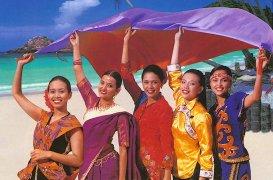LANGUAGES OF MALAYSIA

The indigenous languages of Malaysia belong to the Mon-Khmer and Malayo-Polynesian families. The national, or official, language is Malay which is the mother tongue of the majority Malay ethnic group. The main ethnic groups within Malaysia comprise the Malays, Chinese and Indians, with many other ethnic groups represented in smaller numbers. The largest native languages spoken in East Malaysia are the Iban language and the Kadazan language. English is widely understood in service industries and is a compulsory subject in primary and secondary school. It is also the main language spoken in most private colleges and universities. English may take precedence over Malay in certain official contexts as provided for by the National Language Act, especially in the states of Sabah and Sarawak, where it may be the official working language.
Malaysia contains speakers of 137 living languages, 41 of which are found in Peninsula Malaysia. The government provides schooling in each of the three major languages, Malay, Chinese, and Tamil. Within these three there are a number of dialectal differences.
MALAY
The
official language of Malaysia is known as Bahasa Malaysia. It is a standardised
form of the Malay
language. There are 10 dialects of Malay used throughout
Malaysia. Malay became predominant after the 1969 race riots.A variant of the
Malay language that is spoken in Brunei
is also commonly spoken in East Malaysia.
Example of Malay language :
CHINESE
Chinese
Malaysians mostly speak Chinese dialects from the southern provinces of China. The more common dialects in
Peninsular Malaysia are Cantonese,
Mandarin,
Hokkien, Hakka,
Hainanese, and Fuzhou. The dialect spoken depends on
where the people originated. In Sarawak,
most ethnic Chinese speak either Foochow
or Hakka while Hakka
predominates in Sabah
except in the city of Sandakan
where Cantonese
is more often spoken despite the Hakka-origins
of the Chinese residing there. Hokkien is mostly spoken in Penang, Northern Perak and Kedah
whereas Cantonese is mostly spoken in Ipoh
and Kuala
Lumpur. However, in Malaysia as a whole, the majority of
ethnic Chinese speak Mandarin,
due to it being the most widespread language of business. Some of the less-spoken
dialects such as Hainanese
are facing extinction. As with Malaysian youths of other races, most Chinese
youth are multilingual and can speak up to four languages with at least
moderate fluency - their native Chinese dialect, Mandarin, English and Malay.
Example of Chinese language :
INDIAN
Tamil is used predominantly by Tamils, who form a
majority of Malaysian Indians. It is especially used in Peninsular Malaysia where they still
maintain close cultural ties with their homeland. However, many Indians in East
Malaysia, especially the younger generation, do not speak much Tamil and speak either Malay or English as their first
language.This is because there are far fewer Indians in East Malaysia than in
the Peninsula. Thus, the Indians in East Malaysia prioritise on Malay and English because those languages
are more useful in daily life in that region. Malaysian Tamil is a significant
dialect which is different from Tamil spoken in India, with many loan words
from Malay entering into its vocabulary. Other south Asian languages such as Telugu, Malayalam
and Hindi are also spoken.
Example of Indian language :
LIST OF LANGUAGES
Malay Language :
Malay, Kelantanese, Terengganuan, Kedahan, Sarawakian, Bajau, Negeri Sembilan Malay, Banjar, Bruneian and Indonesian
Malaysian Chinese languages :
Mandarin, Cantonese, Hokkien, Hakka, Foochowese, and Teochew
Malaysian Indian languages :
Tamil which is also by ethnic Tamils of Sri Lankan origin, Hindustani, Malayalam, Telugu, Punjabi, and Gujarati
East Malaysian languages :
Iban, Kadazan, Bajau, Kelabit, Bidayuh, Kayan
Other languages and groups :
English, Burmese, Thai, Sinhalese, Filipinos, Pakistani




Hello, this is a nicely explained article. Your piece was very informative. Thanks for your hard work.
ReplyDeletebranding agency kl
b2b social media agency
graphic design agency kuala lumpur